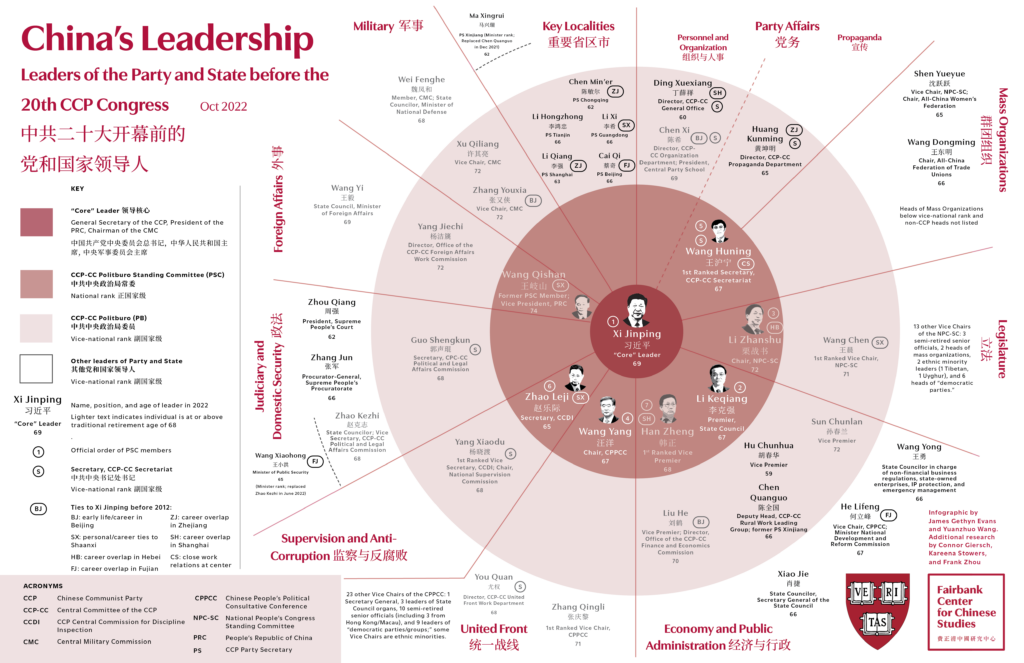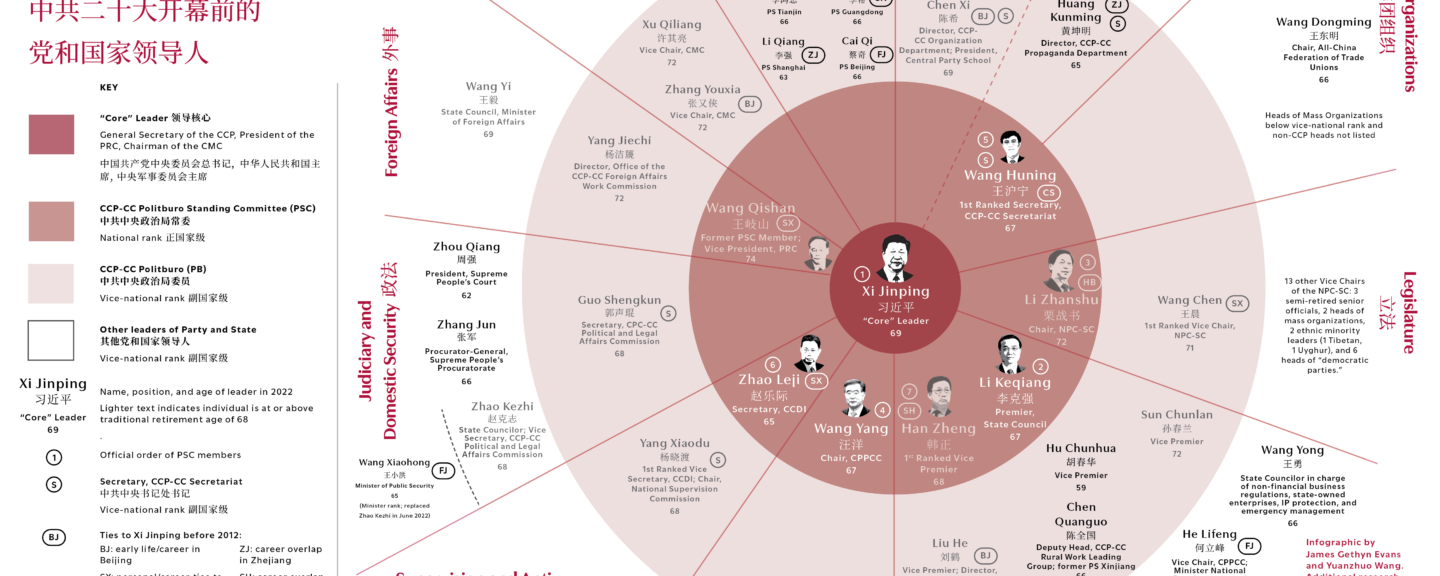As the Chinese Communist Party begins its 20th Party Congress, personnel changes among state and party leaders will dominate headlines. James Gethyn Evans, Communications Officer at the Fairbank Center, and Yuanzhuo Wang, former Research Associate at Harvard Business School, visualize and explain China’s leadership on the eve of the party congress. Additional research for this infographic was compiled by Connor Giersch, Kareena Stowers, and Frank Zhou.
Notable Changes since the 19th Party Congress
Five years ago, we produced an infographic to help to explain “who was in charge of what” at the highest echelons of power in the People’s Republic of China (PRC) after the Chinese Communist Party’s (CCP) 19th Party Congress. Five years on, China’s top state and party leaders have remained relatively stable, with only a few personnel changes at the highest level of power.
The most significant change was the removal of Chen Quanguo as the Party Secretary of Xinjiang in December 2021. Despite this, Chen retained his Politburo seat and was named deputy chair of the party’s Leading Group on Rural Work, chaired by Vice Premier Hu Chunhua. Chen’s predecessor suffered a similar fate and later lost his Politburo seat at the 19th Party Congress; he was then given a sinecure position as Vice Chairman of the National People’s Congress Standing Committee. Given this history, Chen’s ultimate fate remains to be seen.
This past June, Wang Xiaohong, a Xi protégé, also replaced Zhao Kezhi as Minister of Public Security. Zhao is expected to retire between the party congress and next March’s National People’s Congress session. Wang is expected to take over Zhao’s remaining positions and attain vice-national rank (though perhaps not a Politburo seat if recent precedence holds).
Indeed, there is an unwritten (at least not publicly written) rule that leaders above the age of 68 are ineligible for Politburo membership. This rule was observed at the last Party Congress. Wang Qishan did not retain his Politburo Standing Committee seat and was named Vice President (an honorary position) so that he could continue to serve in an advisory – yet influential – capacity. To reflect this rule, our infographic displays leader who turn 68 or older this year as faded in a lighter color.
Some leaders younger than 68 may also retire for political reasons. This included Vice President Li Yuanchao at the last Congress and may include Premier Li Keqiang at the current congress. There is also precedence for Li Keqiang to stay on, possibly as National People’s Congress Standing Committee Chairman as Li Peng did in 1997/1998.
How are Chinese Leaders Appointed?
The Party Congress will elect a new central committee before it closes on October 22, 2022. The new central committee will then convene to elect the new Politburo, its Standing Committee, and the General Secretary. The new leadership lineup is traditionally revealed at the end of the Central Committee meeting, possibly on October 23.
Cascading personnel changes will then occur between when the new party leadership lineup is revealed and when the new National People’s Congress convenes in the spring to formally elect new national leaders based on CCP nominations.

How is China’s Leadership Structured?
China’s “Leaders of Party and State” (党和国家领导人) consists of an exclusive group of around 70 leaders who serve as heads and deputy heads of China’s four leading civilian government institutions plus the Central Military Commission (China’s military high command). These four institutions are:
The Central Committee of the Chinese Communist Party (中共中央)
The center of power that directly controls all senior civil and military appointments (vice-minister rank and above), key national media outlets, the military, and the security apparatus.
The National People’s Congress (NPC)(全国人大)
The legislative branch of government.
The State Council(国务院)
The executive branch of government
The Chinese People’s Political Consultative Conference (CPPCC)(全国政协)
An upper house body that consists of people of influence throughout Chinese society, who are willing to form a “United Front” with the CCP to further its governance.
In addition, the National Supervision Commission (the anti-corruption bureau), the Supreme People’s Court (the judiciary), and the Supreme People’s Procuratorate (prosecutors) are half a rank lower than the four institutions listed above. They formally report to the National People’s Congress but in practice they are overseen by other CCP bodies.
This structure (on the civilian side) is replicated at all levels of government from national to province to prefecture and so on. Not all of these leaders are members of the CCP, but all must accept its leadership role in order to serve as an official.
Combinations of these leaders oversee functional areas of government, as broken out by sections along the circles in the infographic. As you can observe from the infographic, Xi’s close associates (denoted by oval with letters inside) already directly oversee all key functional areas.
The most senior of this group are members of the PSC of the Communist Party’s Central Committee, currently dominated by “Core” leader Xi Jinping, who heads the party, state, and military. Since the 1990s the heads of the three other leading institutions have also received PSC seats. In addition, the second highest leader of the Central Committee’s Secretariat (behind General Secretary) and the State Council, and the head of the party’s anti-corruption body also usually sit on the PSC. The number of seats and composition of the PSC can and has changed over time as the CCP’s current Charter only stipulates the General Secretary of the Party as an ex-officio member.
Download a pdf of the infographic below:

